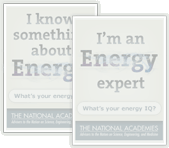
What You Need To Know About Energy
What do you know about energy?
In 2014, how much of the world's CO2 is released by the United States?
-
Sorry, that’s incorrect.
The United States emits about 18% of the world’s greenhouse gases, behind only China, which accounts for approximately one-quarter of total global emissions.
-
Correct!
The United States emits about 18% of the world’s greenhouse gases, behind only China, which accounts for approximately one-quarter of total global emissions.
-
Sorry, that’s incorrect.
The United States emits about 18% of the world’s greenhouse gases, behind only China, which accounts for approximately one-quarter of total global emissions.
-
Sorry, that’s incorrect.
The United States emits about 18% of the world’s greenhouse gases, behind only China, which accounts for approximately one-quarter of total global emissions.
How are battery electric vehicles and hybrid vehicles different?
- Battery electric vehicles receive charge from the electric grid, and hybrid vehicles do not.
- Hybrid vehicles have a gasoline engine and an electric motor that can supplement drive. Battery electric vehicles only have an electric motor.
- Hybrid vehicles consume petroleum onboard when the battery is exhausted. Battery electric vehicles do not consume petroleum onboard.
- Battery electric vehicles emit no carbon dioxide. Hybrid vehicles do emit carbon dioxide
- C and D
-
Sorry, that’s incorrect.
Battery electric vehicles have only a motor and battery, they recharge from the grid and their carbon emissions depend on the energy used to generate the electricity they use. Hybrid vehicles have both a gasoline engine and an electric motor, and use petroleum onboard when their batteries are exhausted. Some hybrid vehicles can charge from the grid and others cannot.
-
Sorry, that’s incorrect.
Battery electric vehicles have only a motor and battery, they recharge from the grid and their carbon emissions depend on the energy used to generate the electricity they use. Hybrid vehicles have both a gasoline engine and an electric motor, and use petroleum onboard when their batteries are exhausted. Some hybrid vehicles can charge from the grid and others cannot.
-
Sorry, that’s incorrect.
Battery electric vehicles have only a motor and battery, they recharge from the grid and their carbon emissions depend on the energy used to generate the electricity they use. Hybrid vehicles have both a gasoline engine and an electric motor, and use petroleum onboard when their batteries are exhausted. Some hybrid vehicles can charge from the grid and others cannot.
-
Sorry, that’s incorrect.
Battery electric vehicles have only a motor and battery, they recharge from the grid and their carbon emissions depend on the energy used to generate the electricity they use. Hybrid vehicles have both a gasoline engine and an electric motor, and use petroleum onboard when their batteries are exhausted. Some hybrid vehicles can charge from the grid and others cannot.
-
Correct!
Battery electric vehicles have only a motor and battery, they recharge from the grid and their carbon emissions depend on the energy used to generate the electricity they use. Hybrid vehicles have both a gasoline engine and an electric motor, and use petroleum onboard when their batteries are exhausted. Some hybrid vehicles can charge from the grid and others cannot.
A typical incandescent lamp (traditional light bulb) consumes 60 watts of power. How much do each of a compact fluorescent and LED lamp consume, in watts, to produce the same amount of light?
-
Sorry, that’s incorrect.
A typical incandescent lamp (traditional light bulb) that consumes 60 watts of power produces around 800 lumens. A compact fluorescent lamp emits the same amount of light while using only 13 watts. And an LED lamp consumes only 10 watts to give off the same 800 lumens.
-
Sorry, that’s incorrect.
A typical incandescent lamp (traditional light bulb) that consumes 60 watts of power produces around 800 lumens. A compact fluorescent lamp emits the same amount of light while using only 13 watts. And an LED lamp consumes only 10 watts to give off the same 800 lumens.
-
Sorry, that’s incorrect.
A typical incandescent lamp (traditional light bulb) that consumes 60 watts of power produces around 800 lumens. A compact fluorescent lamp emits the same amount of light while using only 13 watts. And an LED lamp consumes only 10 watts to give off the same 800 lumens.
-
Correct!
A typical incandescent lamp (traditional light bulb) that consumes 60 watts of power produces around 800 lumens. A compact fluorescent lamp emits the same amount of light while using only 13 watts. And an LED lamp consumes only 10 watts to give off the same 800 lumens.
True or false? Carbon capture and storage would reduce energy efficiency of a coal plant?
-
Correct!
Carbon capture and storage will reduce energy efficiency of a coal plant, though it will decrease carbon emissions.
-
Sorry, that’s incorrect.
Carbon capture and storage will reduce energy efficiency of a coal plant, though it will decrease carbon emissions.
True or False: Burning coal in electric power plants is a major source of CO2 and other emissions. However, its use doesn't have negative consequences beyond the emissions caused by combustion.
-
Sorry, that’s incorrect.
Mining coal disturbs the land and modifies the chemistry of rainwater runoff, which in turn affects stream and river water quality.
-
Correct!
Mining coal disturbs the land and modifies the chemistry of rainwater runoff, which in turn affects stream and river water quality.
What type of transportation uses the most total energy?
-
Correct!
By far the largest share of energy in transportation is consumed by cars, light trucks, and motorcycles—about 58% in 2012, followed by other trucks (21%), aircraft (9%), boats and ships (3%), and trains and buses (3%). Pipelines account for 3% and military uses for 2%.
-
Sorry, that’s incorrect.
By far the largest share of energy in transportation is consumed by cars, light trucks, and motorcycles—about 58% in 2012, followed by other trucks (21%), aircraft (9%), boats and ships (3%), and trains and buses (3%). Pipelines account for 3% and military uses for 2%.
-
Sorry, that’s incorrect.
By far the largest share of energy in transportation is consumed by cars, light trucks, and motorcycles—about 58% in 2012, followed by other trucks (21%), aircraft (9%), boats and ships (3%), and trains and buses (3%). Pipelines account for 3% and military uses for 2%.
-
Sorry, that’s incorrect.
By far the largest share of energy in transportation is consumed by cars, light trucks, and motorcycles—about 58% in 2012, followed by other trucks (21%), aircraft (9%), boats and ships (3%), and trains and buses (3%). Pipelines account for 3% and military uses for 2%.
-
Sorry, that’s incorrect.
By far the largest share of energy in transportation is consumed by cars, light trucks, and motorcycles—about 58% in 2012, followed by other trucks (21%), aircraft (9%), boats and ships (3%), and trains and buses (3%). Pipelines account for 3% and military uses for 2%.
What are ways that electricity system operators match power needs to generation on a day-to-day basis?
- Turning on or off adjustable, load-following generators
- Turning on or off short-term "peaker" plants
- Initiating demand-response actions, such as adjusting thermostats for customers who have agreed to it.
- Initiating energy storage, such as pumped hydro or battery storage.
- All of the above
-
Sorry, that’s incorrect.
Load-following and peaker plants, demand-response and energy storage are all ways that grid operators can adjust generation to meet demand.
-
Sorry, that’s incorrect.
Load-following and peaker plants, demand-response and energy storage are all ways that grid operators can adjust generation to meet demand.
-
Sorry, that’s incorrect.
Load-following and peaker plants, demand-response and energy storage are all ways that grid operators can adjust generation to meet demand.
-
Sorry, that’s incorrect.
Load-following and peaker plants, demand-response and energy storage are all ways that grid operators can adjust generation to meet demand.
-
Correct!
Load-following and peaker plants, demand-response and energy storage are all ways that grid operators can adjust generation to meet demand.
Which of the following is emitted by coal-fired power plants?
-
Sorry, that’s incorrect.
All of the above are emitted from coal-fired power plants and can be harmful to our health and the environment.
-
Sorry, that’s incorrect.
All of the above are emitted from coal-fired power plants and can be harmful to our health and the environment.
-
Sorry, that’s incorrect.
All of the above are emitted from coal-fired power plants and can be harmful to our health and the environment.
-
Sorry, that’s incorrect.
All of the above are emitted from coal-fired power plants and can be harmful to our health and the environment.
-
Correct!
All of the above are emitted from coal-fired power plants and can be harmful to our health and the environment.
What percentage of commercial building energy is used by schools?
-
Sorry, that’s incorrect.
School buildings represent 13% of commercial buildings energy use, or about 2.5% of total U.S. energy use (13% × 19%).
-
Sorry, that’s incorrect.
School buildings represent 13% of commercial buildings energy use, or about 2.5% of total U.S. energy use (13% × 19%).
-
Correct!
School buildings represent 13% of commercial buildings energy use, or about 2.5% of total U.S. energy use (13% × 19%).
-
Sorry, that’s incorrect.
School buildings represent 13% of commercial buildings energy use, or about 2.5% of total U.S. energy use (13% × 19%).
Thank you for taking our quiz.
Place this badge on your facebook page to show your friends what you know about energy.
Place this badge on your facebook page to show your friends what you know about energy.
Place this badge on your facebook page to show your friends what you know about energy.
Explore Other Topics
Energy Hands-on
Understanding Efficiency
Learn the significance of energy efficiencyThe Promise of Better Lighting
Energy savings through lighting technologyOur Energy System
A visualization of all our energy sourcesEnergy Defined
- Biofuels
Liquid fuels typically derived from harvested plant material, used primarily for transportation. These are different from fossil fuels, which are derived from transformed organic material residing in the Earth’s crust for millions of years.




